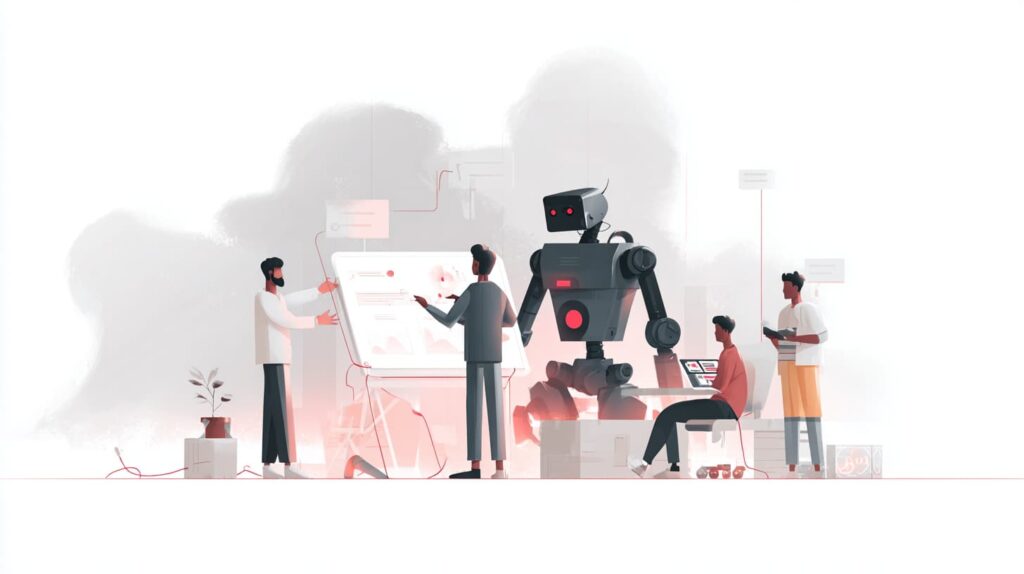By Michele Gasparoto, Carmem Abrantes, Paulo Arthur Mauro and Gabriel Leví
- Diversity, Equity and Inclusion (DE&I) is a cross-cutting issue in society, both personally and in the corporate ecosystem.
- It is essential to understand that this issue is not an exclusive responsibility of a single sector, but rather of the entire company.
- This article explores 10 insights into structuring a DE&I area to boost the debate in the organizations, as well as strengthening its engagement.
In the last decade, there has been a significant increase in the understanding that Diversity, Equity and Inclusion should be a cross-cutting issue in all areas of a company. In other words, everyone in an organization must be committed to reinforcing an inclusive culture and analyzing the processes in which they are involved daily through the lens of DE&I.
In addition to the company’s general commitment, it is important that there is an area dedicated to Diversity, Equity and Inclusion to promote the issue technically, strategically and with a holistic view of the company. Having a dedicated team reinforces the organization’s position in prioritizing and maturing the issue.
Having established an understanding of the importance of having a DE&I department, companies usually have a few questions:
- What is the best way to structure this area?
- How can the area’s activities be delimited in view of the cross-cutting nature of the issue?
- How can the area contribute to making the rest of the company responsible and engaged?
- How can effective governance be established?
To answer these questions – and any others that may arise – we have put together 10 insights gained from projects carried out with clients of different profiles (sector, turnover, number of employees, etc.), which we detail below.
1 - Structuring the DE&I area as a CoE brings important benefits
Establishing the DE&I area as a Center of Expertise (CoE) means setting up a specialized team dedicated to developing best practices on the subject, with the aim of boosting excellence and ensuring consistency and efficiency in how the subject is approached in the organization.
In this way, the agenda is elevated to a level of strategic importance, in addition to strengthening it as a corporate issue and generating accountability in the different areas of the company in an aligned manner, providing autonomy in a responsible and supportive manner, mitigating rework and/or divergence in actions. The following are the 7 main characteristics that a DE&I CoE usually has:
- It specializes in the Diversity, Equity and Inclusion agenda and is made up of professionals with expertise in the subject;
- It defines the DE&I strategy, strategic indicators and targets to be achieved, for the company and for the CoE itself;
- Develops policies, standards and guidelines to promote and direct the agenda at all levels of the organization;
- Develops best practices to promote the issue in the organization. In other words, it structures mechanisms that encourage and accelerate a diverse, equitable and inclusive work environment;
- Structuring awareness and training programs to provide different solutions and means for the company to become DE&I literate;
- Evaluates and monitors the progress of initiatives, drawing up action plans if necessary; and
- It works in collaboration with other areas to support the integration of practices throughout the organization.
Finally, still about structure, it is common for the DE&I area to be part of the Human Resources area or to be connected directly to the company’s CEO. The decision as to where the structure fits in the organization chart is relative, depending on the context of the company. To make this decision, we recommend analyzing the strategy, the span of control of the leadership and the reporting model that best adapts to the company’s culture and reality.
2 - It is crucial to establish a clear value proposition
It is important to define exactly what is expected of this area. Clarity is fundamental because it makes it possible to define an organizational chart, an operating model and governance that enable the desired delivery of value.
These three points are therefore strictly related to the area’s role within the organization. To support the definition of the value proposition, we recommend reflecting on the following three questions:
- What are the main characteristics and competencies for which the area wants to be recognized? Example: reference for technical knowledge, guardian of strategy, ;
- What are the area’s main deliverables? Example: working together with other areas of the company to ensure adherence to DE&I guidelines, portfolio of “on-demand” solutions for literacy, etc.; and
- What impact does DE&I have on the company? Example: areas engaged in the topic, elevated level of literacy maturity in the different areas of the company, etc.
After answering these three points, carry out a diagnosis of the current situation: How far is the present from what is desired? What causes this distance? With the answer in hand, it is time to draw up action plans to reduce the gaps and ensure that the DE&I area occupies the desired space in the organization.
3 - Considering the specificities of each location is key
We started the article by talking about the fact that DE&I cuts across society and is present in all areas of our lives. That is why it is important to consider the context of each location.
Whether it is the culture or legislation of the region, strategy and positioning can be radically altered. This factor becomes even more relevant in the context of a company with global operations, where it is essential for the DE&I area (headquarters) to establish mechanisms that take local realities into account.
Case 1: LGBTQIA+ agenda (Brazil vs. Saudi Arabia)
In Brazil, there are no laws prohibiting same-sex relationships, allowing Brazilian companies to draw up strategic guidelines to increase representation in teams and promote the agenda, bringing visibility to this minority group.
On the other hand, if a Brazilian company with a subsidiary in Saudi Arabia tries to implement this same guideline in the country, it will be breaking the law – given that being a member of the LGBTQIA+ community is considered a crime there. Even if the company does not agree with local legislation, there are external factors that influence the company’s actions that need to be considered. This example is more extreme and explains the concept.
Case 2: Racial agenda (Brazil x Argentina)
Let’s consider a Brazilian company that has a subsidiary in Argentina. To promote Black Awareness Month, the company invested a few thousand reais in advertising to appear in national and Argentinian media outlets to boost its institutional reputation.
But, in Argentina, the racial debate is not as popular as it is in Brazil, nor is November the month of racial awareness. So, while the investment had an impact on Brazilian soil, the results in Argentina were less than expected, while other locally relevant agendas could have been being worked on.
To sum up, to ensure consistency in initiatives and investments and reduce risks, whether in terms of institutional image, legal issues or rework, it is important for the DE&I area to consider the context of each location in which the company operates. Therefore, to make sure that the DE&I area can think globally and act locally, it is important to develop procedures that make it possible to validate or adapt the global guideline to the local context.
4 - Organize the DE&I team based on synergistic responsibilities
When an area is being structured, it is important to consider the coordination axes that make the team’s organization possible. In other words, how activities should be grouped to enable the desired operating model. In general, 6 main axes of coordination can be considered:
- By responsibility: Grouping around the main groups of activities carried out by the area;
- By location: Grouping around the organization’s main locations due to the culture and particularities of each region/country;
- By client/sector: Grouping around the area’s main clients or groups of clients, sectors or market segments;
- By product/service: Grouping around the company’s main product/service divisions;
- By business unit: Grouping around the main combinations of customers and products/services; and
- By marker: Grouping around the identity markers prioritized by the company (e.g. racial, ethnic, LGBTI+, gender, etc.).
Different forms of organization can be considered. For this definition, we recommend evaluating the positioning and value proposition defined for the area, the boundaries of operation, and the context of the company’s culture. In this way, the positive and risky points of each of the coordination axis options can be listed, considering the simplicity of the operating model.
A usual format seen in the market is “by marker”, which organizes the area by prioritized agendas. It works like this: one employee is responsible for all processes relating to the “racial” marker, while another employee is responsible for processes relating to “gender”, etc. The “by marker” coordination axis can make day-to-day work complex for three main reasons:
- Staff will have to carry out several activities which often require different skills and have a different nature of operation;
- Uncertainty and doubts about who should be responsible for handling processes that cut across more than one marker (e.g. a solution for black women); and
- Loss of intersectionality in the construction of solutions and initiatives, as there are employees focused on specific markers.
For this reason, the “per marker” coordination axis is not recommended if the focus is on ensuring increasingly interconnected and connected solutions. Our repertoire shows us that the axes of coordination “by responsibility” and “by locality” are more beneficial.
By responsibility, it is possible to group together tasks with similar competencies and synergies, maximizing day-to-day performance.
For example, in this format, one employee is responsible for creating literacy solutions for all the markers, while another employee is focused on providing consultancy support for other areas, regardless of the topic being dealt with. In this way, there is less deviation in focus and greater specialization in the processes.
The locality axis is a way of considering the particularities of countries and regions, discussed in insight 3.
In any case, before defining the area’s coordination axis, it is important to consider different scenarios, considering the company’s reality.
5 - Establish clear responsibilities and boundaries of action
This insight may seem obvious, but our experience with numerous clients shows that it is often underestimated. There is little point in having a structured DE&I area if the internal stakeholders themselves do not have visibility of the team’s role or do not understand how they can work together and what their responsibilities are. Uncertainties regarding the role of DE&I cause numerous consequences:
- Overlap between the DE&I area and other areas of the company, generating rework and wasted resources;
- Misalignment of action, with areas carrying out initiatives that run counter to DE&I’s strategic guidelines; and
- Loss of capillarity and power of influence in the DE&I area.
To mitigate the above points, it is recommended that a communication plan and governance mechanisms be defined to promote the existence of the DE&I CoE within the company, clarifying its responsibilities and attributions.
6 - Analytics is a strategic differentiator
Some of our clients have an area focused on analytics that meets the needs of other teams by analyzing data to generate insights. This format has numerous benefits, such as gaining scale and high technical quality.
However, there are also points of caution that need to be considered, such as the longer “waiting time” for analysis to be carried out and the division between those who analyze the data and those who have the business context – generating possible misalignments.
In general, having data analysis skills is beneficial and strategic for the DE&I area. This statement can be supported by two main arguments:
- Preventive action for the DE&I context is extremely strategic because the area has the time and space to create action plans to optimize the situation before it becomes a complex problem. To act preventively, in addition to monitoring data and metrics, it is interesting to carry out exploratory analyses on the data available in the company; and
- Finally, the value of generating insights is enhanced by centralizing responsibility for data analysis and interpretation. In other words, the same employee has analytics competence and the business context and technical knowledge in DE&I.
As a decisive point, it is worth noting that the decision on which analytics competency makes up the DE&I CoE should be based on the context and maturity of the organization.
7 - By acting as "sponsor", the top leadership is key to generating capillarity of the theme throughout the company
It is important to consider that, depending on the company’s culture, this insight may have a greater or lesser impact. As mentioned earlier, it is crucial to consider the local culture before applying the insights presented here.
For more hierarchical organizations, it is extremely important for the top leadership to be a spokesperson on the subject and to influence their direct reports, in a top-down manner, so that, in a cascade effect, all areas are impacted.
Generally, in companies with a more traditional profile, it is important for there to be a sponsor of the issue, so that they can talk about DE&I in relevant forums and so that employees understand the importance of the agenda. It is therefore suggested that top management be considered a key player in the governance model for the issue.
Considering companies with a more innovative and less hierarchical profile, insight is also important. The difference is that, in this scenario, top management is more of an actor who influences the ecosystem and not the central figure in ensuring that the issue is prioritized.
8 -The implementation of a governance model that is compatible with the company's reality is essential to reinforce the inclusive culture and bring progress to the issue
As the DE&I theme must be present in the daily lives of all the employees of a company, it is important to deal with the theme considering the ecosystem in which it is inserted. Therefore, we suggest designing a governance model that adheres to the organization’s context, while respecting its own.
The first step in designing the governance model is to identify the players in the DE&I ecosystem. To do this, we suggest the following questions:
- Which actors influence DE&I activities?
- Which areas are most interested in DE&I?
- Which areas demand DE&I the most?
- Are there areas that are neutral and/or detractors of DE&I?
After reflection, it will be possible to draw a stakeholder map, like the example below:
This map depicts, in an illustrative and non-exhaustible way, an example of the company’s Diversity, Equity and Inclusion ecosystem, with the DE&I area itself as the central actor.
Even though all the mapped actors have some kind of interaction with the area, there are key stakeholders who are essential to promoting the agenda and bringing capillarity to the initiatives. So, the second step in establishing the governance model is to prioritize these actors based on the criteria mentioned above: which actors are essential to guaranteeing the development of the DE&I theme?
This point varies depending on the company, but in general, there are actors who are relevant and need to be engaged in any context, such as:
- Top management; and
- Human Resources (BP, culture, recruitment and selection, etc.).
Once the prioritization has been made, all you need to do is establish how the DE&I area will relate to the main players. A crucial point is to draw up a simple governance model to guarantee implementation. An interesting possibility is to define waves of evolution to ensure the rapid implementation of a model that gradually becomes more robust over the months.
9 - When listing the key stakeholders of the governance model, it is important to define the roles and responsibilities of each actor
In addition to the points discussed in insight 8, to ensure an implementable and realistic governance model, it is important to define the role and responsibility of each actor. In other words, how each of the stakeholders interacts with the issue and adds value to the DE&I discussion. The governance model is more than just a framework that visually shows how the actors interact.
This exercise also helps to validate whether the proposed governance model adheres to reality and that there are no “discovered” attributions without a well-defined person in charge. By establishing roles and responsibilities, it is clear how the different actors complement each other and the boundaries of action between them.
We stress the importance of considering the reality of each actor in the model to draw up roles and responsibilities that are implementable. As discussed in insight 8, it is best for the governance model to begin simply and then add any kind of complexity. This logic also applies to stakeholder attribution: it can evolve as the discussion matures.
10 - To make up the governance model, it is important to consider forums and initiatives that support the development of the agenda and stakeholder engagement
Based on the projects and benchmarks carried out, we have put together 5 forums/initiatives that are typically used by organizations in governance models:
- Executive DE&I Committee;
- DE&I Committee;
- Affinity Groups;
- DE&I Journey; and
- Specific DE&I Literacy Trail.
Executive DE&I Committee:
- Made up of the company’s top leadership (e.g. CEO, HR Director, Head of DE&I);
- They establish the DE&I strategy, ensuring alignment with the overall strategy and cohesion with the culture;
- Define DE&I targets for the company; and
- Monitoring the performance of strategic indicators to recalculate the route when necessary.
DE&I Committee:
- Formed by the top leadership of key areas for promoting a diverse, equitable and inclusive culture in the company;
- Ensures the presence of the DE&I lens in a top-down manner in the key areas;
- Holds key areas jointly responsible for advancing the issue in the company; and
- Analyze the strategic guidelines, standards and goals to ensure that they adhere to the reality of the different areas of the company.
Affinity groups:
- Formed organically, they are made up of employees who identify with one of the minorities agendas;
- They support the DE&I area in unfolding initiatives, influencing and mobilizing their peers;
- They consolidate insights and feedback from the top to support the DE&I area in improving its processes;
- They have a certain level of autonomy based on the DE&I strategic guidelines (e.g. they plan initiatives, promote meetings, etc.); and
- They are essential for mobilizing, engaging and reinforcing an inclusive organizational culture.
DE&I Journey:
- Mechanism to give concrete responsibility to the key areas and enable structured exchange with the DE&I area; and
- It is the responsibility of each key area to prioritize its own processes, which should be reviewed and built in partnership with the DE&I area – based on the strategic guidelines and DE&I targets.
Specific DE&I literacy trail:
- A mechanism for raising awareness and educating the different actors in the governance model about DE&I issues in a personalized and specific way, suited to each one’s context and needs;
- It brings together the basic content that each actor in the governance model should be aware of; and
- It has the bias of onboarding on the subject or even recycling knowledge, as well as generating catalysts for DE&I awareness.
Conclusion
This article has provided 10 insights to guide the structuring of a DE&I area, considering lessons learned from projects and good market practices. Once again, it is worth emphasizing that the insights are general and are not tailored to a specific company profile. It is therefore necessary to refine the content before implementing it in an organization.
EloGroup is ready to offer our expertise on the subject, accumulated from projects implemented in organizations on a global scale, to support your team on this journey. Does your company want to structure or even restructure its DE&I department? Talk to us!
MICHELE GASPAROTO works as Senior Consultant at EloGroup.
CARMEM ABRANTES works as Manager at EloGroup.
PAULO ARTHUR MAURO works as Partner and Director at EloGroup.
GABRIEL LEVÍ works as Head of Diversity, Equity and Inclusion at EloGroup.













